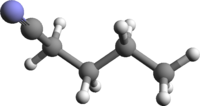|
The chain-like normal isomer of butyl cyanide,
n-C4H9CN, may exist in
five different conformations. Low-resolution infrared
spectroscopy and molecular mechanics calculations
were reported by
(1) G. A. Crowder, 1989,
J. Mol. Struct. (Theochem), 200, 235.
The anti-anti- (or AA-) conformer
was found to be lowest in energy. The heavy atoms
form a planar zig-zag structure in this conformer.
The gauche-anti- (or GA-) conformer,
with the cyano group rotated by about 120o,
is only slightly higher in energy, by about 65 K.
The AG-conformer, with the methyl group
rotated by about 120o, is about 440 K
higher in energy, and the GG'-conformer, with
both group rotated about 120o away from each
other, is about 440 K higher in energy. The
GG-conformer, with both groups rotated
toward each other, is much higher higher in energy
than the AA-conformer, around 1000 K.
This conformer was not considered or seen in (1).
Note: While
the AA-conformer is unique, all others
are conformationally doubly degenerate because
the rotations can be performed clockwise as well
as counter-clockwise.
Transition frequencies < 22 GHz were taken
from
(2) R. K. Bohn, J. L. Pardus, J. August,
T. Brupbacher, and W. Jäger, 1997,
J. Mol. Struct., 413–414, 293;
14N hyperfine structure was resolved
for several transitions.
Extensive additional transitions were reported
by
(3) M. H. Ordu, H. S. P. Müller, A. Walters,
M. Nuñez, F. Lewen, A. Belloche, K. M. Menten,
and S. Schlemmer,
2012, Astron. Astrophys., 541, Art. No. A121.
Predictions with uncertainties much larger than
0.5 MHz should be viewed with caution. This
should not be any limitation for astronomical
observations.
14N hyperfine structure is unlikely to be
resolved in astronomical observations.
Note: The
main entry has been calculated assuming the
GA-conformer to be 65 K higher
than AA and taking into consideration
the conformational degeneracy. Since the
energy difference is very uncertain, an
alternative entry is provided with energy origin
at zero and the factor of 2 in the degeneracy removed.
The corresponding
energy file and
partition function values are available. Note also
that the partition function does not include
contributions from other vibrations or conformers.
The dipole moment components were estimated in (2).
Deviations from the estimates are probably small,
but not necessarily negligible.
|
